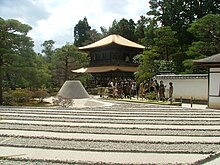Ginkaku-ji
| Jishō-ji 慈照寺 | |
|---|---|
 The kannonden at Jishō-ji, commonly known as the Silver Pavilion (Ginkaku) | |
| Religion | |
| Affiliation | Zen, Rinzai sect, Shōkoku-ji school |
| Deity | Shaka Nyorai (Śākyamuni) |
| Location | |
| Location | 2 Ginkakuji-chō, Sakyō-ku, Kyōto, Kyoto Prefecture |
| Country | Japan |
| Architecture | |
| Founder | Ashikaga Yoshimasa |
| Completed | 1490 |
| Website | |
| http://www.shokoku-ji.jp/g_about.html# | |
Ginkaku-ji (銀閣寺, lit. "Temple of the Silver Pavilion"), officially named Jishō-ji (慈照寺, lit. "Temple of Shining Mercy"), is a Zen temple in the Sakyo ward of Kyoto, Japan. It is one of the constructions that represents the Higashiyama Culture of the Muromachi period.
History
Ashikaga Yoshimasa initiated plans for creating a retirement villa and gardens as early as 1460;[1] and after his death, Yoshimasa would arrange for this property to become a Zen temple.[2] The temple is today associated with the Shokoku-ji branch of Rinzai Zen.
The two-storied Kannon-den (観音殿, Kannon hall), is the main temple structure. Its construction began February 21, 1482 (Bummei 14 , 4th day of the 2nd month).[3] The structure's design sought to emulate the golden Kinkaku-ji which had been commissioned by his grandfather Ashikaga Yoshimitsu. It is popularly known as Ginkaku, the "Silver Pavilion" because of the initial plans to cover its exterior in silver foil; but this familiar nickname dates back only as far as the Edo period (1600–1868).[4]
During the Ōnin War, construction was halted. Despite Yoshimasa's intention to cover the structure with a distinctive silver-foil overlay, this work was delayed for so long that the plans were never realized before Yoshimasa's death. The present appearance of the structure is understood to be the same as when Yoshimasa himself last saw it. This "unfinished" appearance illustrates one of the aspects of "wabi-sabi" quality.[2]
Like Kinkaku-ji, Ginkaku-ji was originally built to serve as a place of rest and solitude for the Shōgun. During his reign as Shōgun, Ashikaga Yoshimasa inspired a new outpouring of traditional culture, which came to be known as Higashiyama Bunka (the Culture of the Eastern Mountain). Having retired to the villa, it is said Yoshimasa sat in the pavilion, contemplating the calm and beauty of the gardens as the Ōnin War worsened and Kyoto was burned to the ground.
In 1485, Yoshimasa became a Zen Buddhist monk. After his death on January 27, 1490 (Entoku 2, 7th day of the 1st month),[5] the villa and gardens became a Buddhist temple complex, renamed Jishō-ji after Yoshimasa's Buddhist name.
After extensive restoration, started February 2008, Ginkaku-ji is again in full glory to visit. The garden and temple complex are open to the public. There is still no silver foil used. After much discussion, it was decided to not refinish the lacquer to the original state. The lacquer finish was the source of the original silver appearance of the temple, with the reflection of silver water of the pond on the lacquer finish.
Garden
In addition to the temple's famous building, the property features wooded grounds covered with a variety of mosses. The Japanese garden, supposedly designed by the great landscape artist Sōami. The sand garden of Ginkaku-ji has become particularly well known; and the carefully formed pile of sand which is said to symbolize Mount Fuji is an essential element in the garden.
Gallery
-
In winter
-
Winter view
-
Autumn view from the pond
-
Togudo Hall in Fall
-
Tōgu-dō (1486),
a National Treasure -
Ginshadan
-
Approach
-
Kannon-Hall and Pond
-
Kogetsudai, Ginkaku-ji, Kyoto
See also
- The Glossary of Japanese Buddhism for an explanation of terms concerning Japanese Buddhism, Japanese Buddhist art, and Japanese Buddhist temple architecture.
- Historic Monuments of Ancient Kyoto (Kyoto, Uji and Otsu Cities)
- List of National Treasures of Japan (residences)
- List of Special Places of Scenic Beauty, Special Historic Sites and Special Natural Monuments
- Tourism in Japan
Notes
- ^ Yamasa: Gikaku-ji.
- ^ a b "Protecting Ginkaku-ji, the Beauty of Wabi-sabi; Reluctance to Black Lacquering the Outer Wall," Kyoto Shimbun. January 23, 2008.
- ^ Keene, Donald. (2003). Yoshimasa and the Silver Pavilion, p. 87.
- ^ Keene, p. 88.
- ^ Titsingh, p. 361.
References
- Keene, Donald. (2003). Yoshimasa and the Silver Pavilion: The Creation of the Soul of Japan. New York: Columbia University Press. ISBN 978-0-231-13056-1; OCLC 52268947
- Titsingh, Isaac, ed. (1834). [Siyun-sai Rin-siyo/Hayashi Gahō, 1652], Nipon o daï itsi ran; ou, Annales des empereurs du Japon. Paris: Oriental Translation Fund of Great Britain and Ireland.









